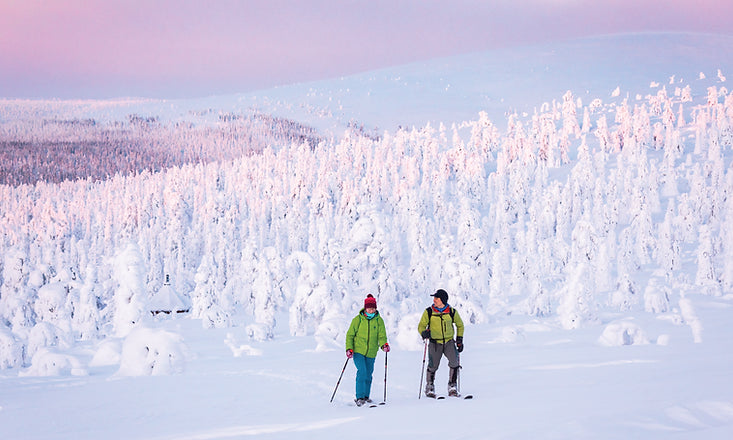
Sliding on the snowdrifts
Snow trekking is a mix of skiing and snowshoeing the easiest way to get started. It is the most leisurely and easiest form of Skinbased skiing. It borrows some techniques from classic cross-country skiing, the most notable being the diagonal stride. However, the stride when using snow trekkers is much shorter and slower than with cross-country skis.
The skis best suited for snow trekking are shorter and broader than other backcountry skis. In our ski line we recommend both the WAP and the KAR for grown-up skiers, and the POH for kids. Both the WAP and the POH have composite edges that are both kid and dog-friendly. These make perfect skis for frosty family adventures, and the WAP is great for hunting trips with dogs. For conditions when the snow is firmer, the KAR is the better choice due to its steel edges. In the end, the more comfortable you are at snow trekking, the less the ski selection matters.
Snow trekking, generally, is an excellent way to move in dense forests and other terrain that requires agility from the equipment. With snow trekkers, winter trekkers, foresters, hunters, guides, photographers, and others can access the winter locations they dream of.
Purpose: leisurely and fun winter exploring
Difficulty level: easy to learn, easy to do
Terrain: flat to moderately rolling terrain
Backcountry adventuring
Maybe you are already an experienced winter trekker and have basic XC skiing skills. Why not combine the two into a single, great experience? Skinbased trekking trips can range from a quick outing along your favorite, well-marked hiking trail, to multi-week expeditions, far away from civilization. While you can choose your own level of intensity, the basics remain the same.
The classic diagonal stride will be your go-to technique for traveling across most moderate terrain. Additionally, it’s good to be familiar with a few basic techniques for climbing and descending on skis. The traversing technique is useful when moving on angled ground. When traveling uphill, skiing back and forth, across the fall line of the slope, makes for an easier and more efficient ascent. The traversing technique can also be used when skiing down, to better control speed.

As with any new activity, it is best to start off slow. Day trips on familiar trails, possibly the same you have hiked on during the warmer months, make for ideal first backcountry outings. As your comfort and experience grows, more audacious trips can be attempted.
Purpose: longer outings, experience wilderness
Difficulty level: moderate
Terrain: rolling terrain
Skiing laps in the hills
Do you know of a secret backyard powder stash that would be just perfect for skiing on, if only it had a lift? Do you have a solid understanding of backcountry, downhill, or telemark skiing? If so, then using Skinbased skis to “skin up” and make turns coming down is possibly the most fun gift winter can give.
One of the beauties of traveling with Skinbased skis is how seamlessly they transition from uphill to downhill. There is no switching ski modes or messing about with sticky climbing skins every time you change terrain types. You can freely ski up, across, and down, all without having to stop and change a thing. The feeling of freedom this brings is immense. Shorter, yet still exciting hills that were once overlooked now beckon to be skied. The rules have changed, and now so much more terrain can be your playground!

The best skis for “running laps'' are ones that excel at both climbing and descending. The Skinbased XCD BC 160 and XCD GT 160 for adults, and the XCD GT 137 for youngsters are all ideally suited for the challenges of all-terrain skiing. With their slightly narrower profile, these skis are the easiest to put on edge. This allows for increased turning performance, especially on hardpack snow.
If you like the idea of this style of Skinbased skiing, but aren't sure where to go, some great places to start your search include nearby national parks, hilly forests, open glades, and even some fruit orchards (as always, be sure to get landowner permission before skiing). For us, we find the ideal terrain to be shorter hills, with a maximum vertical climb of 200 meters and terrain angles from 10-20 degrees. The Skinbased crew’s favorite spot involves paying a visit to a certain old and now abandoned gravel quarry, but shh! Let’s not say our secret powder playground too loudly.
Purpose: excitement, develop new skill sets
Difficulty level: moderate to difficult, depending on terrain
Terrain: hilly terrain with slopes of 5 to 15+ degrees
__
So, which style of Skinbased skiing are you most drawn to? Here at OAC, we love them all. We are grateful for our Skinbased skiers across the globe, who continue to inspire us with their own unique styles and adventures. Our range of versatile products was created with the vision of allowing people to follow their winter passions, wherever they may lead. We look forward to seeing you all out there on the next snow day!

1 commentaire
These skis (both KAR and WAP) are perfect for backcountry on the Niagara Escarpment in Canada.
With the WAPs, you’re good to go anywhere you’d snowshoe. No more tramping down a snowshoe track before skiing after a big snowfall. And with universal bindings, no more uncomfortable X-country ski boots!!! Would love if Skinbased made some powder-friendly poles…